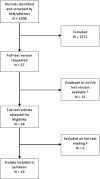Electrical neurostimulation for the treatment of chronic pruritus: A systematic review
- PMID: 34637585
- PMCID: PMC9299998
- DOI: 10.1111/exd.14468
Electrical neurostimulation for the treatment of chronic pruritus: A systematic review
Abstract
Approximately one fifth of the world population experiences continuous itch for 6 weeks or more during their life, that is chronic itch. It is diverse in its aetiologies, and it is notoriously hard to treat. Because itch and pain have largely overlapping pathophysiology and the demonstrated efficacy of neurostimulation in treatment of selected chronic pain conditions, we conducted a systematic review to investigate whether neurostimulation could be an effective treatment for chronic itch. We identified two randomized controlled trials and 17 open label studies or case reports investigating various neurostimulation modalities for the treatment of refractory itch of various aetiologies. Transcutaneous electrical nerve stimulation (TENS) was the most investigated modality (n = 17), and in the largest number of conditions. Other modalities were cutaneous field stimulation (n = 2), painscrambler (n = 1), transcranial direct current stimulation (n = 1) and peripheral nerve field stimulation (n = 1). Atopic dermatitis was the most studied condition (n = 5). Despite the large heterogeneity in used stimulation paradigms and outcome parameters, all studies reported a positive effect of at least one neurostimulation modality. Our review indicates that electrical neurostimulation could be considered for the treatment of refractory chronic itch of selected aetiologies, such as atopic dermatitis or burn pruritus. However, better understanding of the mechanisms of action of the neurostimulation modalities and regimens in various pruritic conditions is necessary.
Keywords: chronic pruritus; itch; neurostimulation; therapy.
© 2021 The Authors. Experimental Dermatology published by John Wiley & Sons Ltd.
Conflict of interest statement
All authors declare they have no affiliations with or involvement in any organization or entity with any financial interests, or non‐financial interests in the subject matter or materials discussed in this manuscript.
Figures

References
-
- Yosipovitch G, Greaves MW, Schmelz M. Itch. Lancet. 2003;361:690‐694. - PubMed
-
- Yosipovitch G, Rosen JD, Hashimoto T. Itch: from mechanism to (novel) therapeutic approaches. J Allergy Clin Immunol. 2018;142:1375‐1390. - PubMed
-
- Yosipovitch G, Bernhard JD. Clinical practice. Chronic pruritus. N Engl J Med. 2013;368:1625‐1634. - PubMed
-
- Ständer S, Schäfer I, Phan NQ, et al. Prevalence of chronic pruritus in Germany: results of a cross‐sectional study in a sample working population of 11,730. Dermatology. 2010;221:229‐235. - PubMed
Publication types
MeSH terms
LinkOut - more resources
Full Text Sources
Medical
Research Materials

